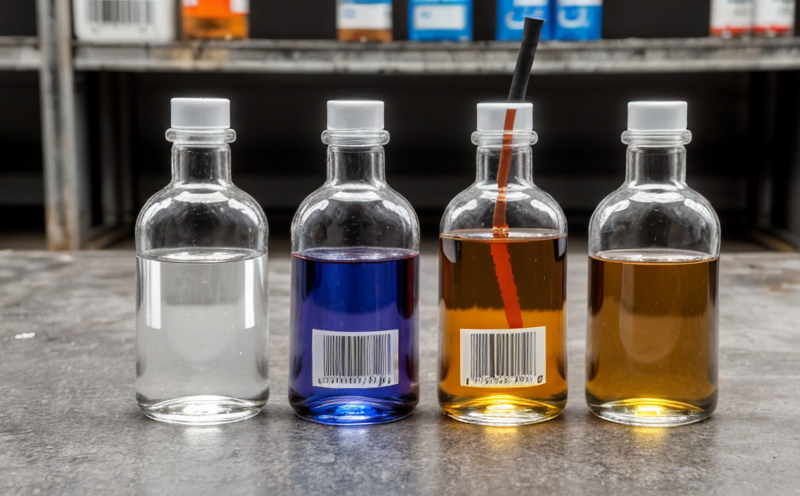Chemical Stability and Degradation Testing
Chemical stability and degradation testing is a critical process in ensuring that chemical products meet quality standards over their intended shelf life. This service focuses on evaluating the stability of chemicals under various environmental conditions such as temperature, humidity, light, and pressure. The goal is to identify potential changes or degradations in chemical properties which could impact product performance, safety, and regulatory compliance.
These tests are essential for industries including pharmaceuticals, cosmetics, paints & coatings, petrochemicals, and electronics. In the pharmaceutical sector, understanding how active ingredients degrade can lead to more effective drug formulations. For electronic components, stability testing helps ensure longevity and reliability under varying conditions. The results of these tests guide formulation adjustments, storage recommendations, and compliance with international standards.
Our laboratory uses state-of-the-art equipment and follows strict protocols set by recognized bodies like ISO, ASTM, and IEC to conduct comprehensive chemical stability assessments. We employ a range of techniques including accelerated aging, oxidative degradation studies, photostability testing, and thermal cycling, among others. Each test is customized based on the specific requirements provided by our clients.
One key aspect of this service involves sample preparation. Depending on the type of chemical being tested, samples may need to be prepared in different ways. For instance, solid materials might require grinding or dissolution into appropriate solvents before analysis. Liquid samples often involve precise volumetric measurements and dilutions if necessary. Understanding these nuances allows us to deliver accurate results that reflect real-world scenarios.
The equipment used for chemical stability testing includes advanced spectrophotometers capable of measuring UV-visible light absorption spectra, chromatography systems for separating complex mixtures, calorimeters for monitoring heat release during reactions, and environmental chambers simulating specific atmospheric conditions. By leveraging this sophisticated instrumentation, we can provide detailed insights into how chemicals behave over extended periods.
Reporting is another crucial component of our service offering. Clients receive comprehensive reports detailing the outcomes of their tests along with recommendations based on findings. These documents serve multiple purposes such as aiding in decision-making processes related to product development or production adjustments; supporting compliance efforts towards regulatory requirements; and facilitating communication between stakeholders involved in the supply chain.
| Standard | Description |
|---|---|
| ISO 14690:2021 | Guidelines for the design and operation of cleanrooms used in pharmaceutical production. |
| ASTM D5873-15 | Standard test method for determining photostability of solid materials using a xenon arc light source. |
| IEC 60252-4:2019 | Specification for temperature and humidity conditioning chambers used in electrical and electronic product testing. |
Customer Impact and Satisfaction
Implementing robust chemical stability programs not only enhances the quality of products but also contributes significantly to customer satisfaction. By ensuring that our clients’ products maintain their integrity throughout storage and use, we help them build trust with end-users who rely on consistent performance from purchased goods.
For pharmaceutical manufacturers, demonstrating compliance with stringent regulatory guidelines is paramount. Our testing services provide the necessary data to support submissions made to health authorities like FDA or EMA, thereby accelerating approval processes. This ultimately leads to faster market entry for new medications while minimizing risks associated with early withdrawals due to unforeseen issues.
In consumer goods industries such as cosmetics and personal care products, maintaining colorfastness and preventing odors from developing over time are important factors influencing customer loyalty. Our expertise in photostability testing ensures that these attributes remain intact even after prolonged exposure to sunlight or other adverse conditions encountered during transportation or storage.
From a broader perspective, implementing best practices for chemical stability contributes positively towards sustainable development goals by reducing waste through extended product lifecycles and minimizing environmental impact associated with frequent replacements caused by premature failures due to degradation.
International Acceptance and Recognition
- The results of our chemical stability tests are widely accepted across multiple countries including USA, Europe, Japan, China, India, South Korea, Australia, New Zealand, and many others.
- Compliance with international standards enhances brand reputation and facilitates smoother trade negotiations between different jurisdictions.
- Our testing protocols meet or exceed requirements stipulated by major regulatory bodies worldwide ensuring seamless acceptance of our clients' products wherever they operate globally.





